Symphony of Calibrated Perfection: The Art and Science of Pressure Sensors
Welcome to the world of pressure sensor calibration, where precision meets reliability in the pursuit of accurate measurements! Calibrating pressure sensors is like fine-tuning the ears of a musician—ensuring they hear every note crisply and accurately. It’s a meticulous process, akin to fine-tuning an orchestra to produce harmonious melodies.
In this realm, each calibration step is a symphony of precision, from setting up reference standards to orchestrating adjustments that refine a sensor's accuracy. Picture a dance between technology and precision, where instruments, calibration software, and meticulous attention ensure that pressure sensors deliver trustworthy measurements across industries and applications.
Embark on this journey with me as we unravel the intricacies of pressure sensor calibration, exploring the tools, methodologies, and significance of this process in maintaining the heartbeat of countless industries where precise pressure measurements are the key to operational excellence.
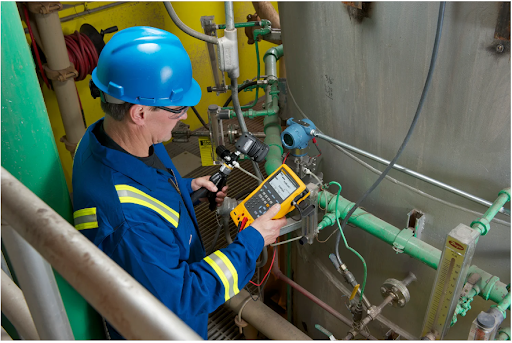
Fig 1. An engineer is calibrating a pressure sensor
Calibration process for pressure sensors
Calibrating pressure sensors involves a meticulous process to verify and adjust their output to align with known and traceable standards. Typically, it begins with zero calibration, where the sensor is exposed to no pressure or atmospheric pressure, and adjustments are made to ensure the sensor's output reflects this baseline accurately. Subsequently, span calibration is conducted by applying known pressures within the sensor's operational range, allowing for adjustments to ensure precise alignment between the sensor readings and the expected values at these specific pressures. Additionally, for enhanced accuracy, intermediate point calibrations might be performed to assess linearity across various pressure levels within the sensor's range. Throughout this process, meticulous documentation of calibration data, adjustments made, and validation checks is crucial for compliance and traceability.
An essential aspect of pressure sensor calibration is the utilization of reliable reference standards and appropriate equipment, such as calibration software and pressure sources capable of generating precise pressures. Following manufacturer guidelines, maintaining a stable environment, and handling the sensor with care is vital for accurate calibrations. Regular recalibration, documented in certificates detailing the process and adjustments, ensures ongoing accuracy, enabling pressure sensors to provide reliable measurements critical across industries such as manufacturing, healthcare, and automotive, where precise pressure readings are integral to operational success and safety.
Here’s a general process for calibrating pressure sensors:
Equipment Needed
Step-by-step guide to calibrating pressure transmitters
Here’s a step-by-step guide to calibrating pressure transmitters:
Step 1: Preparation
Tips:
- Follow the sensor manufacturer’s instructions for calibration.
- Ensure a stable environment during calibration (temperature, humidity, etc.).
- Use proper handling techniques to prevent damage to the sensor.
- Maintain proper documentation for traceability and compliance purposes.
Remember, proper calibration ensures the accuracy and reliability of pressure sensor measurements, critical for various applications across industries like manufacturing, automotive, aerospace, and more.
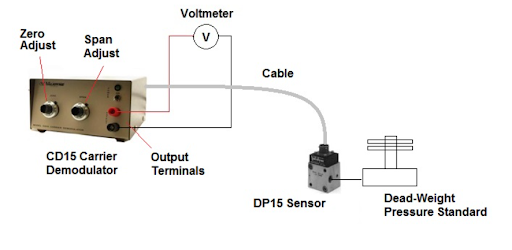
Fig 2. Pressure measurement and calibration
Why is calibration important for pressure sensors?
Calibration is vital for pressure sensors due to several key reasons:
What is the pressure sensor calibration equipment?
Pressure sensor calibration requires specific equipment to ensure accurate and reliable results. Here are some essential tools commonly used in pressure sensor calibration:
Reference standards
Reference standards are fundamental tools used in calibration to establish known and traceable values against which the accuracy of measurement instruments, such as pressure sensors, is compared and adjusted. These standards are devices or instruments that have undergone rigorous calibration themselves, often by accredited laboratories, to ensure their accuracy and reliability. They serve as benchmarks, providing known and stable values of pressure or other physical quantities used during the calibration process.
These standards come in various forms depending on the specific measurement being calibrated. For pressure sensors, reference standards might include deadweight testers, pressure balances, or precision pressure controllers. Each standard is calibrated against higher-level standards, ultimately tracing its accuracy back to national or international standards maintained by metrology institutes. The accuracy and traceability of reference standards are pivotal; they ensure that the calibration process maintains consistency and reliability, allowing for the adjustment and validation of the sensor's measurements against known and trustworthy values. This process ensures that the sensors provide accurate and dependable readings across their specified range of operation.
What are the pressure sensor calibration standards?
Pressure sensor calibration standards refer to the recognized and established benchmarks used as references during the calibration process to verify and adjust pressure sensors for accuracy and reliability. These standards are crucial in ensuring that pressure sensors provide precise measurements within their specified range.
Several widely recognized pressure sensor calibration standards are used across industries:
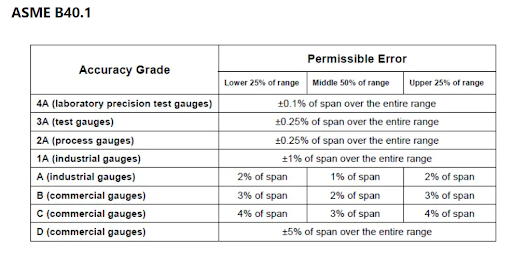
Fig 3. ASME B40.1 defines the accuracy grades of dial-type gauges
Pressure sensor calibration standards table
Creating a comprehensive table detailing pressure sensor calibration standards involves listing various standards alongside their respective accuracies, pressure ranges, traceability, and common applications. Here’s an example to illustrate how such a table might look:
Table 1. Calibration standards
| Calibration Standard | Accuracy | Pressure Range | Traceability | Common Applications |
| National Metrology Institute Standards | ±0.01% to ±0.005% of reading | Varies based on specific standards | Traceable to national/international standards | Calibration laboratories, research institutions |
| Deadweight Testers | ±0.02% to ±0.005% of applied pressure | From vacuum to high pressures (e.g., 1 psi to 100,000 psi) | Traceable to primary standards | Industrial calibration, high-pressure applications |
| Precision Pressure Controllers | ±0.01% to ±0.005% of set pressure | Typically up to 10,000 psi | Traceable to primary standards | Laboratory calibrations, manufacturing |
| Pressure Balances | ±0.005% to ±0.001% of applied pressure | High pressures (e.g., 1,000 psi to 100,000 psi) | Traceable to primary standards | Aerospace, defense, high-pressure systems |
| Calibrated Pressure Gauges/Transducers | ±0.05% to ±0.01% of full scale | Varies based on gauge/transducer range | Traceable to higher-level standards | Industrial processes, quality control |
This table serves as an example and doesn't cover all available standards or their specific details. The accuracy, pressure range, traceability, and applications can vary significantly depending on the specific model or manufacturer. For detailed and accurate information, it's essential to refer to the documentation provided by the calibration standards’ manufacturers or calibration laboratories.
Pressure source role in the calibration process
Pressure sources play a pivotal role in the calibration process by providing precise and controlled pressure levels necessary to verify and adjust the accuracy of pressure sensors. These sources are responsible for generating pressures within the range of the sensor being calibrated, allowing technicians to compare the sensor's output against known and traceable pressure values. The accuracy and stability of the pressure source directly impact the reliability and precision of the calibration procedure.
Various types of pressure sources are used depending on the calibration requirements, such as pneumatic pumps, hydraulic systems, pressure controllers, or gas cylinders with known pressures. These sources are calibrated against higher-level standards to ensure their accuracy and traceability. By accurately producing specific pressure levels, these sources facilitate the calibration of pressure sensors across their operational range, enabling adjustments to the sensor’s output to align with the expected values.
During calibration, the pressure source’s stability and precision are crucial factors. Fluctuations or inconsistencies in the pressure output can lead to inaccurate calibration results. Therefore, pressure sources often incorporate features to maintain stability, such as regulators, valves, and precise measurement mechanisms. Additionally, the calibration technician must carefully control and monitor the pressure source to ensure it remains within the required accuracy tolerances throughout the calibration process. The reliability and precision of pressure sources are fundamental to achieving accurate and dependable calibrations, ensuring that pressure sensors provide precise measurements essential for various industrial and scientific applications.
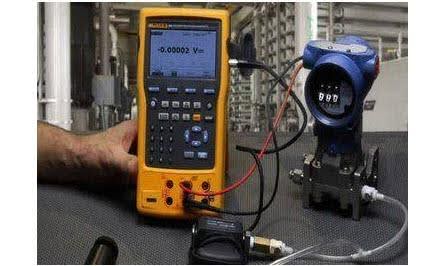
Fig 4. Pressure sensor calibration process
Calibration Software
Calibration software serves as a central tool in the calibration process, enabling technicians to efficiently manage, automate, and document calibration procedures for various instruments, including pressure sensors. This software streamlines the calibration workflow by providing functionalities to schedule calibrations, record measurements, perform calculations, and generate detailed calibration reports. It often includes features for data analysis and trending, allowing technicians to track instrument performance over time.
One of the key roles of calibration software is its ability to ensure compliance with industry standards and regulations. It facilitates adherence to calibration schedules, maintains historical records of instrument calibrations, and generates certificates or reports that document each calibration event. Additionally, some advanced calibration software integrates with measurement devices, allowing for direct data capture and reducing manual input errors. This not only enhances the accuracy of calibration but also improves the overall efficiency of the calibration process by reducing human intervention and streamlining data management.
Overall, calibration software significantly enhances the precision, consistency, and traceability of calibration activities. By providing a centralized platform for managing calibration tasks, it helps organizations maintain the accuracy of their instruments, meet regulatory requirements, and ensure the reliability of measurements across various industries, including manufacturing, pharmaceuticals, aerospace, and more.
What is the pressure sensor calibration software?
Several software options are available for pressure sensor calibration, each offering varying features for managing calibration procedures, data recording, analysis, and generating calibration reports. Some commonly used pressure sensor calibration software includes:
How can use this software?
Using pressure sensor calibration software typically involves several steps:
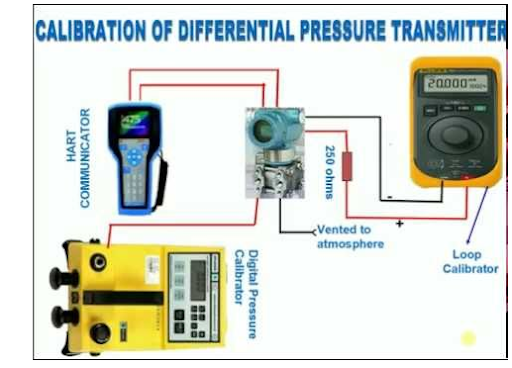
Fig 5. Calibration of Differential pressure transmitter
Pressure Indicators or Manometers role in the calibration process
Pressure indicators or manometers play a crucial role in the calibration process, serving as instruments used to measure and display pressure levels during the calibration of pressure sensors. These devices come in various types, including analog and digital pressure gauges, transducers, and manometers, each with its specific accuracy, resolution, and pressure range capabilities.
During calibration, pressure indicators or manometers act as the intermediary between the pressure source and the sensor being calibrated. They allow technicians to verify and compare the pressure levels generated by the calibration equipment with the readings obtained from the sensor under test. This comparison is pivotal in assessing the accuracy and performance of the sensor.
Precision and accuracy are vital characteristics of these instruments. Calibration-grade pressure indicators or manometers are calibrated against higher-level standards to ensure their accuracy and traceability to recognized standards. Their accuracy should match or exceed the accuracy requirements of the sensors being calibrated to minimize measurement uncertainties during the calibration process.
Additionally, pressure indicators or manometers should possess appropriate resolution and sensitivity to detect small pressure variations accurately. This is especially important when calibrating highly sensitive or precise pressure sensors. The ability to provide consistent and stable readings throughout the calibration process ensures reliable and trustworthy comparisons between the pressure source and the sensor, facilitating accurate adjustments to the sensor's output if necessary. Regular calibration and maintenance of these instruments are essential to uphold their accuracy and reliability in pressure sensor calibration procedures.
Fixtures and Adapters in the calibration process
Fixtures and adapters are crucial components in the calibration process, especially when dealing with pressure sensors of various shapes, sizes, and connection types. They serve the purpose of securely and accurately connecting the sensor being calibrated to the calibration equipment, ensuring proper alignment and sealing to maintain accuracy during the calibration process.
These fixtures and adapters come in a variety of forms to accommodate different types of pressure sensors and calibration setups. They include:
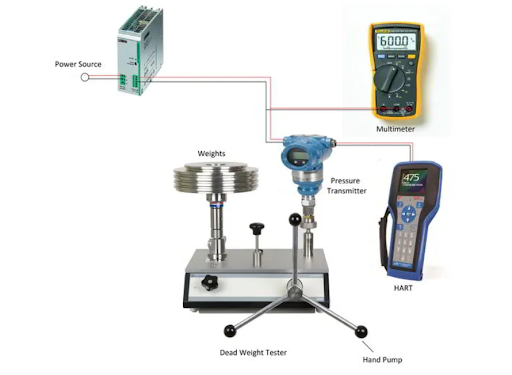
Fig 6. Calibration system
Data Recording Tools
Data recording tools are essential components in the calibration process, facilitating the collection, storage, and analysis of calibration data during the evaluation of pressure sensors. These tools come in various forms and are used to capture and document measurements obtained during the calibration procedure.
What data recording tools are needed in the calibration process?
In the calibration process for pressure sensors, several data recording tools are commonly utilized to accurately capture and manage calibration data:
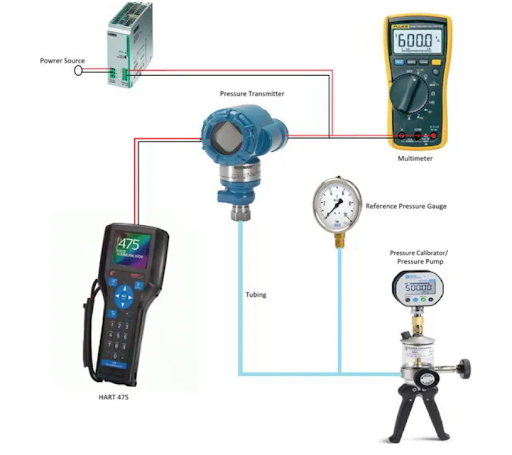
Fig 7. Pressure sensor calibration
Temperature and Environmental Controls in the Calibration Process
Temperature and environmental controls are crucial aspects of the calibration process, especially when dealing with pressure sensors, as changes in environmental conditions can significantly impact sensor readings. Controlling temperature, humidity, and other environmental factors during calibration ensures accuracy and consistency in pressure measurements.
Maintaining a stable temperature is essential because pressure measurements can be sensitive to changes in temperature. Temperature variations can affect the properties of gases or liquids used in pressure generation, impacting the accuracy of calibration. Temperature-controlled chambers or rooms are often utilized to ensure a consistent temperature environment during calibration. Additionally, using temperature sensors or probes in proximity to the pressure sensor being calibrated helps monitor and record temperature variations throughout the process.
Humidity control is also critical, particularly in situations where moisture could affect the performance of the pressure sensor or the calibration equipment. High humidity levels might lead to condensation, affecting measurements and potentially causing damage to sensitive components. Environmental controls include dehumidifiers or climate-controlled rooms to maintain stable humidity levels.
Furthermore, shielding the calibration setup from external factors like air drafts, vibrations, electromagnetic interference, and other contaminants is essential for precise measurements. Enclosures or shields may be employed to protect the equipment from such influences, ensuring reliable and repeatable calibration results.
Overall, temperature and environmental controls in the calibration process ensure the stability and integrity of pressure sensor measurements. By minimizing the impact of environmental fluctuations, these controls contribute to the accuracy, repeatability, and reliability of calibration procedures, crucial for obtaining trustworthy pressure sensor readings across various applications and industries.
What is the safety equipment for the calibration process?
Safety equipment is vital during the calibration process to ensure the well-being of technicians and maintain a safe working environment. Some essential safety equipment used in pressure sensor calibration includes:
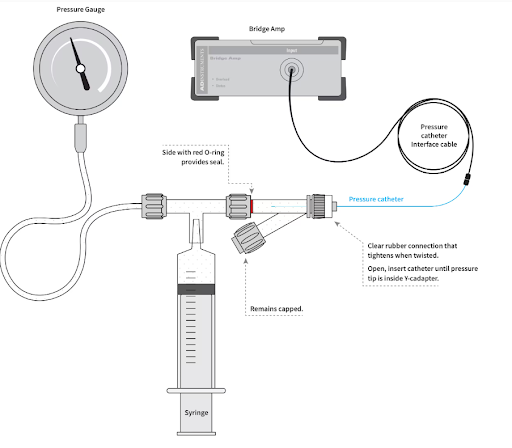
Fig 8. Air calibration system
Conclusion
In the realm of pressure sensor calibration, meticulous attention to detail, precision, and safety stands as the cornerstone of ensuring accurate and reliable measurements. The calibration process involves a series of meticulous steps, from utilizing reference standards and specialized equipment to employing calibration software for data management and analysis.
Central to this process is the role of pressure sources, fixtures, and adapters, which facilitate accurate connections and the generation of precise pressure levels necessary for calibration. Additionally, pressure indicators and data recording tools play pivotal roles in capturing, analyzing, and documenting calibration data, contributing to the accuracy and traceability of the calibration process.
Environmental controls, encompassing temperature and humidity regulation, along with safety measures and equipment, ensure a secure working environment and safeguard the integrity of the calibration process. These aspects, combined with rigorous adherence to safety protocols and personal protective equipment, mitigate risks and ensure the well-being of technicians involved in calibration procedures.
Overall, pressure sensor calibration demands a meticulous approach, incorporating specialized tools, adherence to safety standards, and a commitment to precision. By adhering to these practices, calibration endeavors maintain accuracy, uphold reliability, and underpin the foundation for precise pressure measurements across various industries and applications.
To recap
1. What is pressure sensor calibration?
Answer: Pressure sensor calibration is the process of verifying and adjusting the output of a pressure sensor to align with known and traceable standards. It ensures that the sensor provides accurate and reliable pressure measurements.
2. Why is pressure sensor calibration necessary?
Answer: Calibration ensures the accuracy and reliability of pressure sensors. Over time, sensors might drift or lose accuracy due to environmental factors or normal wear. Calibration verifies their performance and adjusts readings if necessary.
3. How often should pressure sensors be calibrated?
Answer: Calibration frequency depends on various factors, including sensor type, usage conditions, and industry standards. Typically, sensors are calibrated annually, but critical applications might require more frequent calibrations.
4. What equipment is needed for pressure sensor calibration?
Answer: Equipment includes reference standards (e.g., deadweight testers), pressure sources, fixtures/adapters for connections, pressure indicators, calibration software, and data recording tools.
5. What is the calibration process for pressure sensors?
Answer: Calibration involves zero calibration (adjusting at no pressure), span calibration (adjusting across the sensor's range), intermediate point checks if needed, data recording, validation, and certification.
6. Can pressure sensor calibration be done in-house?
Answer: Yes, many organizations conduct in-house calibration. However, using accredited calibration labs or services might ensure adherence to strict standards and traceability.
7. How accurate should the calibration standards be?
Answer: Calibration standards should be more accurate than the sensor being calibrated. Standards typically have accuracies ranging from 0.01% to 0.001% of the applied pressure.
8. What precautions should be taken during calibration?
Answer: Maintain a stable environment, handle sensors with care, follow manufacturer guidelines, use appropriate PPE, and ensure proper documentation throughout the process.
9. Can pressure sensor calibration be automated?
Answer: Yes, some calibration processes can be automated using calibration software or data acquisition systems, reducing human intervention and improving efficiency.
10. What happens if a pressure sensor fails calibration?
Answer: If a sensor fails calibration, adjustments are made to bring it within acceptable limits. If adjustments fail to improve accuracy, the sensor might need repair or replacement.
References
https://www.transmittershop.com/blog/important-calibration-tips-for-pressure-sensors/
https://www.fluke.com/en-us/learn/blog/calibration/pressure-transducer-calibration
https://instrulearning.com/pressure/how-to-do-a-pressure-calibration/
https://www.adinstruments.com/support/knowledge-base/how-do-i-calibrate-pressure-transducer
https://www.validyne.com/blog/basics-validyne-pressure-sensor-calibration/
https://www.precisionmass.com/how-to-calibrate-a-pressure-transmitter/
https://www.transmittershop.com/Assets/images/FCUIEagle/1/Blog_200X112/Blog3.png
https://instrumentationtools.com/pressure-gauge-calibration-procedure/#google_vignette
Recent Posts
-
Booster Pump Troubleshooting and Maintenance: How to Fix and Prevent Common Issues
1. Introduction Imagine turning on your faucet only to be greeted with a weak trickle of water when …22nd Apr 2025 -
Energy-Efficient Booster Pumps: Selection and Tips for Maximizing Performance
1. Introduction Imagine never having to deal with fluctuating water pressure, noisy pumps, or skyroc …19th Apr 2025 -
Booster Pumps for Sustainable Water Systems: Irrigation and Rainwater Harvesting Solutions
1. Introduction Water scarcity is no longer a distant threat—it’s a reality affecti …16th Apr 2025




